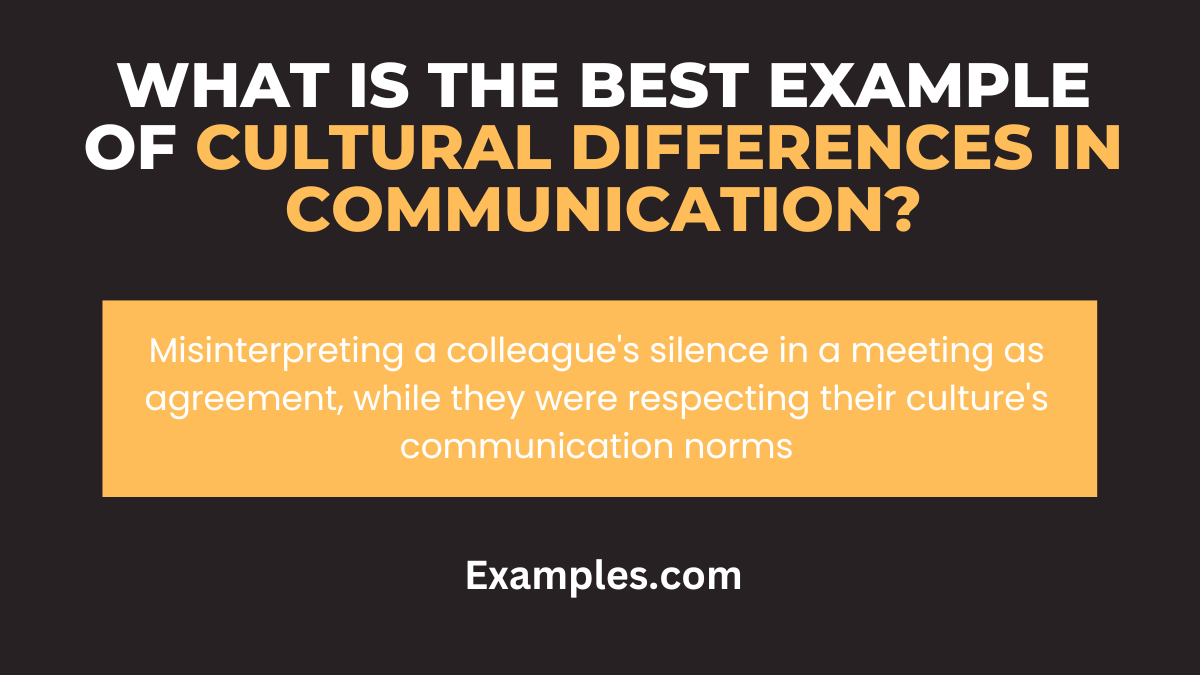19+ Cultural Differences in Communication Examples
Understanding cultural differences in communication is crucial in our interconnected world. This comprehensive guide delves into the subtleties and complexities of intercultural communication. It explores how diverse cultural backgrounds influence the way people interact, express themselves, and perceive messages. Whether you’re working in a global team, studying abroad, or simply keen to broaden your horizons, mastering cultural differences in communication is an invaluable skill. Embark on a journey to enhance your cross-cultural communication skills, fostering deeper connections and mutual respect in diverse settings.
What is the Best Example of Cultural Differences in Communication?

Cultural differences in communication are best exemplified by the varied interpretations of non-verbal cues across different cultures. For instance, in Western cultures, direct eye contact is often perceived as a sign of confidence and honesty. In contrast, in some Asian cultures, direct eye contact can be seen as disrespectful or confrontational. This stark difference highlights how cultural backgrounds can drastically alter the understanding and effectiveness of non-verbal communication.
20 Examples of Cultural Differences in Communication

Cultural differences in communication are pivotal in shaping interactions globally. This list explores diverse communication styles, from non-verbal cues to conversational norms, highlighting how culture influences the way we connect with others. Understanding these differences is crucial in today’s interconnected world, enhancing cross-cultural awareness and reducing misunderstandings. Each example offers a snapshot of unique communication practices, reflecting the rich tapestry of global interactions.
- Greetings and Formality: In Japan, bowing shows respect, while a firm handshake is preferred in the U.S. Example: In Japan, greet with a bow saying, “Hajimemashite,” while in the U.S., extend your hand and say, “Pleased to meet you.”
- Eye Contact Norms: In many Western cultures, direct eye contact signifies confidence, whereas in some Asian cultures, it can be seen as disrespectful.
Example: In the U.S., maintain eye contact during a conversation, saying, “I understand your point,” but in Asia, you might avert your gaze and say, “I am listening carefully.” - Personal Space: Americans value personal space, but in Middle Eastern cultures, closer physical proximity is common.
Example: In the U.S., stand a few feet apart during a conversation, while in the Middle East, standing closer is acceptable. - High vs. Low Context Communication: Asian cultures often use indirect communication (high context), while Western cultures are more direct (low context).
Example: In Japan, you might hint at a refusal with “It’s difficult,” whereas in the U.S., you’d directly say, “No, thank you.” - Silence Interpretation: In Western cultures, silence can be awkward, but in Eastern cultures, it’s a sign of respect and thoughtfulness.
Example: In a U.S. meeting, fill silence with small talk, but in Japan, use silence to reflect and then respond. - Time Perception: Punctuality is crucial in Germany, while in Brazil, a more relaxed approach to time is common.
Example: In Germany, be on time saying, “I value punctuality,” but in Brazil, being a bit late is acceptable. - Gesture Differences: Thumbs up is positive in the U.S. but offensive in parts of the Middle East.
Example: In the U.S., show approval with a thumbs up, but in the Middle East, avoid using it. - Expressiveness: Italians are known for their expressive communication, unlike the reserved style in Japan. Example: In Italy, use hand gestures for emphasis, while in Japan, keep gestures subdued.
- Form of Address: Using first names is common in Australia, while titles and surnames are preferred in Korea.
Example: In Australia, use first names saying, “Nice to meet you, John,” but in Korea, use titles like, “Nice to meet you, Mr. Kim.” - Gift-Giving Etiquette: In China, gifts are exchanged as a part of business culture, unlike in Sweden. Example: In China, present a small gift saying, “I hope you like this,” but in Sweden, gifts are not typically exchanged in business settings.
- Dining Etiquette: In India, eating with your hands is customary, unlike in the U.K., where utensils are used. Example: In India, use your hands to eat, saying, “This is delicious,” but in the U.K., use a fork and knife.
- Consensus vs. Individual Decision: In Japan, group consensus is valued, while in the U.S., individual decisions are common.
Example: In Japan, discuss with the group before making a decision, while in the U.S., you might decide independently. - Directness in Feedback: Americans are usually direct in feedback, whereas Chinese might use indirect criticism. Example: In the U.S., say “This needs improvement,” but in China, suggest “Perhaps we could consider other options.”
- Conflict Resolution: In many Asian cultures, harmony is prioritized over confrontation, unlike in the U.S. Example: In Asia, approach conflict gently, saying, “Let’s find a common ground,” while in the U.S., you might directly address the issue.
- Nonverbal Communication: In Brazil, physical contact is a part of communication, unlike in Japan. Example: In Brazil, a pat on the back is friendly, while in Japan, maintain a respectful distance.
- Humor in Communication: British humor is often subtle and dry, unlike the more straightforward humor in the U.S.
Example: In the U.K., use witty remarks, while in the U.S., opt for more direct jokes. - Hierarchy in Communication: In India, respecting hierarchy is important, unlike in Denmark, which has a flatter organizational structure.
Example: In India, show deference to higher-ups, saying, “As you suggest,” but in Denmark, engage more casually with superiors. - Religious Sensitivities: In Muslim countries, religious considerations impact communication, unlike in secular nations.
Example: In Muslim countries, be mindful of religious contexts, while in secular countries, religion is less likely to influence business conversations. - Negotiation Style: Americans tend to be aggressive negotiators, unlike the consensus-building approach in Japan.
Example: In the U.S., push for your terms, saying, “Here’s my best offer,” while in Japan, seek a mutually agreeable solution. - Emphasis on Written vs. Oral Communication: In Germany, written communication is preferred for clarity, unlike in Spain, where oral agreements are common.
Example: In Germany, confirm agreements in writing, while in Spain, verbal agreements are often sufficient.
What are Cultural Differences in Nonverbal Communication?
- Facial Expressions: Different cultures interpret facial expressions in unique ways. While a smile may be universally recognized, expressions like frowning or surprise can have different meanings across cultures.
- Eye Contact: In some cultures, direct eye contact signifies confidence and honesty, whereas, in others, it might be seen as rude or confrontational.
- Gestures: Common gestures such as nodding or shaking hands can have vastly different meanings in various cultural contexts.
- Personal Space: The acceptable distance during interactions varies; some cultures prefer close proximity, while others value a larger personal space.
- Body Language: Posture and body movements are interpreted differently across cultures. For example, some cultures view hands in pockets as disrespectful.
Why is Cultural Difference a Barrier to Communication?
- Misinterpretation of Gestures: Common gestures in one culture may be offensive or misunderstood in another, leading to miscommunication.
- Language Nuances: Beyond words, understanding the cultural context of language usage is critical; jokes, idioms, and sarcasm might not translate well across cultures.
- Different Communication Styles: Some cultures are direct in their communication, while others use a more indirect approach. This can lead to confusion or perceived rudeness.
- Preconceived Stereotypes: Cultural stereotypes can lead to biased assumptions about communication styles or intentions.
- Emotional Expression Norms: The way emotions are expressed varies widely, with some cultures being more expressive and others more reserved.
How Do You Communicate with Someone with Cultural Differences?
- Active Listening: Pay attention to understand the context and the subtleties of what is being said.
- Cultural Sensitivity: Be aware of and respect the cultural norms and practices of the other person.
- Clear and Simple Language: Avoid slang, idioms, and complex language that might be misunderstood.
- Feedback for Understanding: Regularly check for understanding and ask for clarification to avoid misinterpretation.
- Adaptability: Be willing to adapt your communication style to better align with the other person’s cultural background.
Cultural differences in communication is vital for successful interactions. This article has provided a comprehensive guide and valuable tips for bridging communication gaps across diverse cultures. By embracing cultural sensitivity, active listening, and adaptability, individuals and businesses can foster inclusive and effective communication, ultimately strengthening global relationships and achieving their communication goals.



